We are now in León, staying at a wonderful family-run hotel on a beautiful square in the old part of the city. Directly across the square from our hotel is the Basilica de San Isidoro. Many churches along the Camino de Santiago offer to stamp your “Credential del Peregrino” (Pilgrim Credential), including this one. I mentioned the amazing museum adjoining the Basilica – this is a Must-See for anyone who visits León. Rick Steves mentions it in his book on Spain. The ceiling frescoes are truly unique and beautifully preserved for the most part:
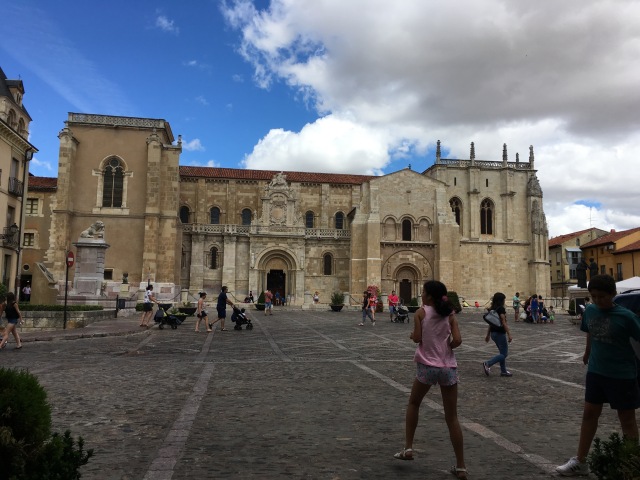
The Cathedral in León is definitely worth visiting, especially if you happen to be in town during their organ series, which features very interesting repertoire performed by many of Europe’s most well-known organists. Unfortunately, we arrived after the series had ended for the summer. But a big marquee in front of the Cathedral posts the entire series.
While it is true that the Cathedral is Burgos is so incredible that it dwarfs many others in this part of Spain, I agree with Rick Steves, who says that its stained glass windows are among the most beautiful anywhere. On the day we visited, it was dark and cloudy, so I didn’t get as many high-quality photos of the stained glass windows as I would have liked. But here are a few very lovely photos of the Cathedral:



Wood carving in the choir stalls – León Cathedral
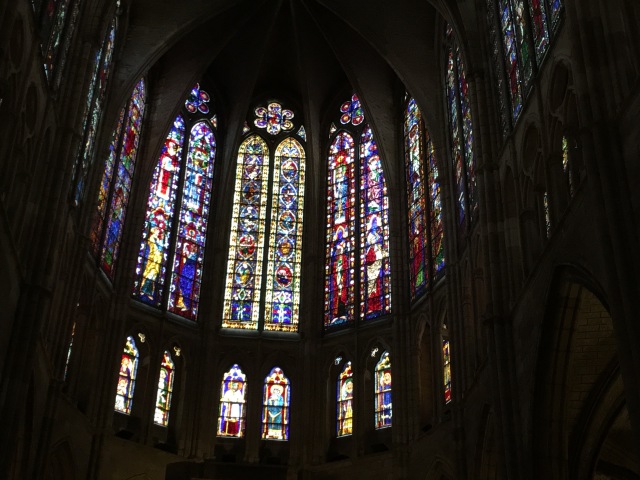
We had just dropped our rental car off in León and would be taking the train to Sarría, the starting point for the last 120 kilometers that pilgrims must walk entirely on foot in order to earn their Compostela. You may have seen me standing before the Cathedral in Santiago de Compostela at the end of our pilgrimage, holding my Compostela up to the camera. In case you didn’t, I will post it again when we arrive in Santiago.
The train trip from León to Sarría was very pleasant. The weather in Castilla y León was incredibly hot throughout our travels by car. And we had walked many miles in the cities and towns that we visited between July 15 and 21. We now find ourselves with a final night in León, then a day-long train trip to Sarría, where we check into our hotel and go to dinner at a fantastic restaurant named “Roma”:
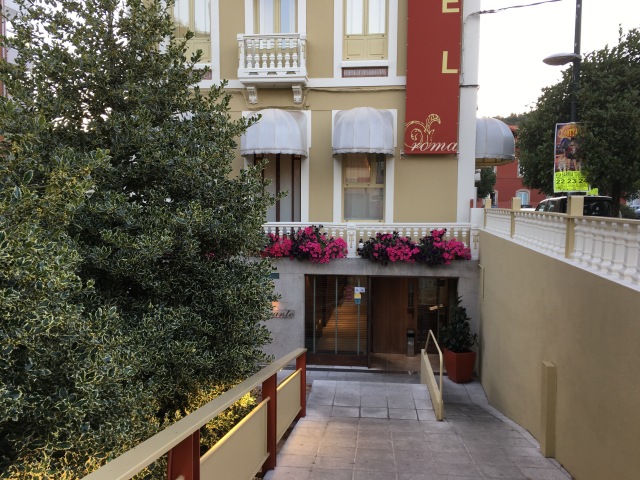
Despite its Italian name, the restaurant actually serves fantastic roasted meats and Jamón Serrano – a characteristically Spanish menu – along with great wine and sides. A typical dinner in various parts of northern Spain consists of a starter, such as roasted peppers, various tapas or a salad, followed by a cutlet, often roast pig or lamb, and French fries. (I must not neglect to mention that Spanish French fries are much closer to their French counterparts than they are to fries here in the US.) They also serve great bread with every meal, and I grew to love it, despite the fact that it was white or country bread. It actually reminds me of the fresh Italian bread that my immigrant family served at home when I was growing up.
This was one of the best meals we had on the entire Camino – and there were quite a few excellent ones! Roma in Sarría is highly recommended! And the prices for meals on the Camino are very affordable, even at somewhat upscale places such at this.
Day 1 of our Camino was filled with surprises. To begin with, my partner brought a backpack that was too heavy to carry. I had done a bit of research and managed to send most of my heavier items ahead to our hotel in Santiago de Compostela. My own backpack was around 17-18 pounds, which was very doable throughout the week-long pilgrimage on foot. The other thing that came to have meaning was that my flute was in my backpack. It could not be mailed back to the US from Germany, so it came along. More on the musical messages that accompanied us on the Camino in the next few installments.
The first surprise was the terrain – admittedly, I was beginning to get an idea of what the portion of the Camino in Galicia would be like from the train ride to Sarría. Truth be told, most English-language guides to the Camino do not tell pilgrims just how challenging the Walk can be. We certainly got a quick introduction to the challenges of hiking in mountainous terrain that first day, because the initial long stretch to the next town was almost entirely uphill in intense heat and humidity. The views were spectacular, but we were not entirely prepared for the demanding trek.
Here is a photo of our first stop at a lovely albergue in a small farming village. I have also posted a few photos of the countryside and farms that are typical of this part of Spain. The young couple across from us and pictured here were from Denmark and Sweden. We had a lovely conversation with them – they were stopped there for a day because his feet were seriously hurt from 6 weeks on the Camino and at least partly due to inadequate shoes. I was thanking my guide books for good information about foot care, and it would come in handy over the next week:
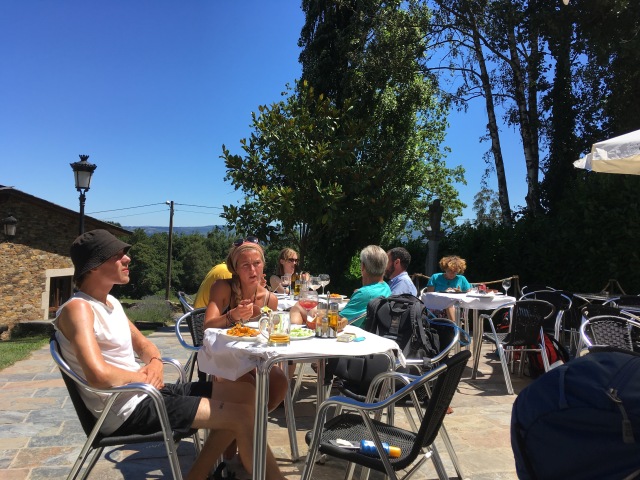
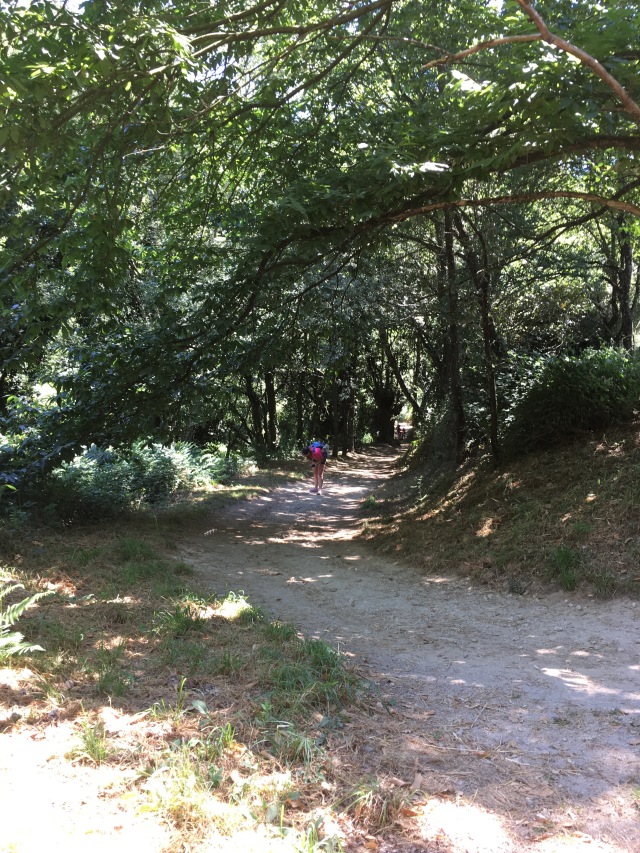

These markers ensure that pilgrims do not get lost in the countryside on the Camino.
Another important factor that guidebooks do discuss is hydration. Particularly in summertime, when the temperatures can be well into the 90s F, it is crucial to drink enough water. Everyone takes at least 1 water bottle along, attached to his/her backpack. But this is not enough, so there are many little inns along the way where one can stop for a rest and to drink one’s fill. If you are considering a pilgrimage on the Camino, please be sure to take this warning very seriously. On Day 1 I actually felt awful after the first part of the walk to the albergue pictured above. As soon as I drank a large bottle of water, it became clear that the reason was dehydration!
The next pointer for pilgrims along the Camino in Galicia is that an entire taxi industry has grown up in towns and cities along the route. This is because many people do not prepare sufficiently for their walk – either their backpack is too heavy, they have the wrong shoes for such a demanding series of paths, they overestimate the number of kms/miles they can cover in a single day, and/or they don’t train for the Camino.
The fact that we live at 7,200 ft above sea level is actually helpful if one trains here by hiking the many wonderful trails available in Santa Fe and around New Mexico. And I was never so grateful for my yoga practice, which allowed me to walk strenuous paths without having any major injuries, such as muscle cramps, ankle pain, etc. Although I did feel a bit of soreness from the long, uphill climbs, it was all within the realm of normal.
We, in fact, succumbed to the overestimation of our ability to cover distances in a single day. Whereas we had planned on walking between 20 and 30 kms per day on average, we were actually only able to do about half to three-quarters of that distance. That first day we took a taxi to our hotel in Portmarín, checked in and enjoyed a wonderful dinner in the open air on the square across from our hotel. The topic that evening was to recalculate what we could actually manage in the coming days.
Portomarín was a significant stop along the Way because something happened there that made a deep impression on us. As we were headed to dinner, a funeral was taking place in the church immediately in front of the restaurant. The man who had died must have been someone known to the community, because the square was filled with mourners. When one is on a pilgrimage, taking time out from this incredibly fast-paced life, one is struck by the realization that the ultimate destination is acceptance of the end of life. This could not have been more clear to us that evening.
Portomarín is on a beautiful river. Here are several photos of the town and surrounding area. The first two photos are of the countryside en route to Portomarín from Sarría:

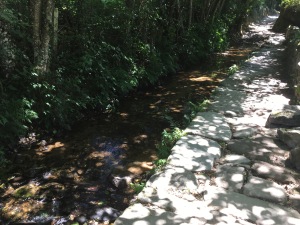

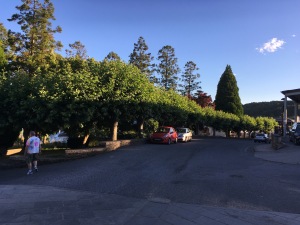
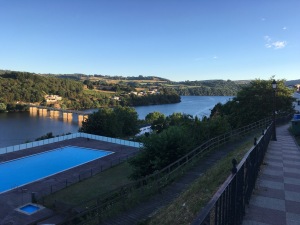
We were up reasonably early the next morning for Day 2 of our walk on the Camino. More on that in the next installment.
Tonight we watched “Immortal Beloved”, a truly great film about Beethoven’s life directed by Milos Forman. Seeing it again compelled me to write a few words about Beethoven’s music and the film. If you haven’t seen it, you may want to order it from Netflix.
When the film first came out, the trailers about it were rather off-putting, so we didn’t see it for some years after it was released. But we now own a copy and watch it several times per year.
Part of what makes the film great, apart from the directing and cinematography, is the quality of the soundtrack: Sir Georg Solti conducting the London Symphony in some of Beethoven’s greatest orchestral works and pianist, Murray Perahia, one of my personal favorites, playing parts of the “Moonlight” and several of Beethoven’s other most famous piano sonatas and concerti.
No author of Greek tragedies could have penned a story more heartbreaking than Beethoven’s real-life biography. Just imagine the profound effect that his hearing loss had on his life, relationships, and work. It is beyond ironic that one of the greatest Western composers to have ever lived wrote some of his greatest works while profoundly to completely deaf. Would Beethoven himself have felt that his legacy was worth the suffering he endured throughout his life, sometimes at his own hands?
Our personal library has a copy of Anton Schindler’s last biography of Beethoven, “Beethoven as I Knew Him,” in the English translation from the original German. With the film fresh in our consciousness, we now plan to read it again.
As it happens, NMPAS is doing a work by Beethoven, the Serenade Opus 25, for flute, violin and viola with members of the La Catrina Quartet, based at New Mexico State University in Las Cruces. It will be featured at the Annual Valentine’s concerts in Los Alamos and Santa Fe on February 4 & 5, 2017.
The Camino de Santiago Part III
We are now in Burgos, the historical capital of Castilla. Our hotel was literally across the square from the Burgos Cathedral, which we visited on the afternoon that we arrived in the City. Two hours before closing time were barely enough to absorb the richness, beauty and artistic wealth of this cathedral, which is one of the most beautiful and profound that I have ever seen. Here are photos of the cathedral that will convey something of that beauty:
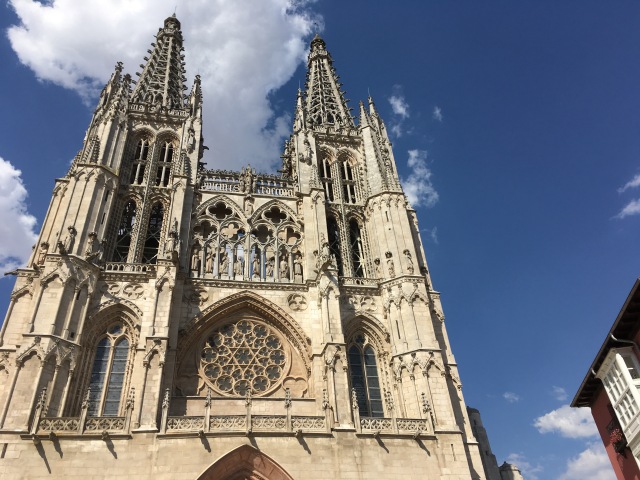
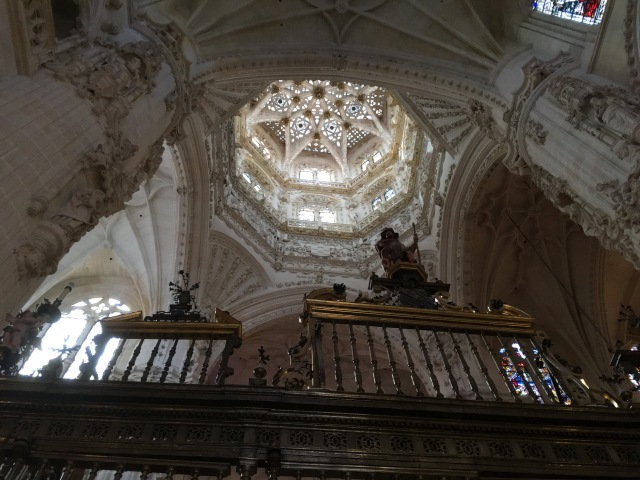
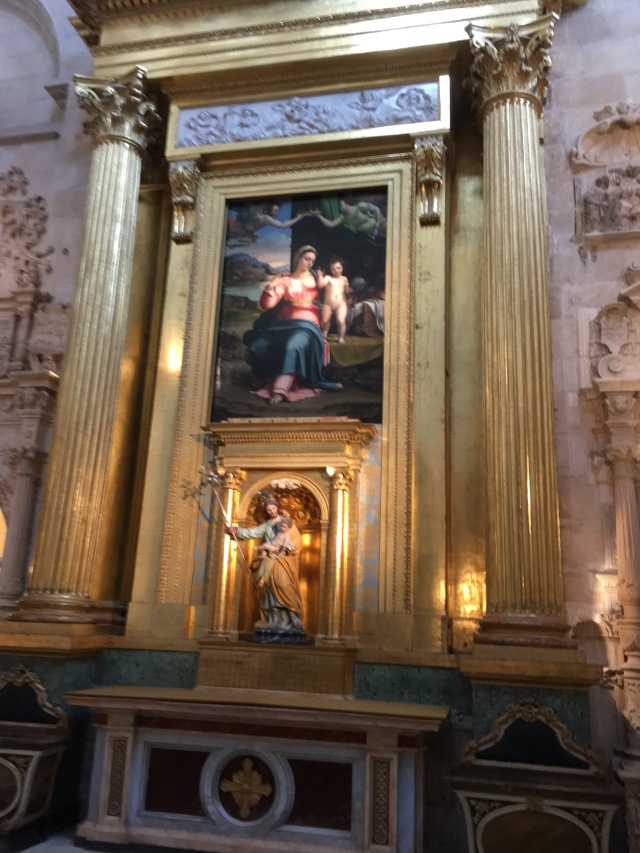

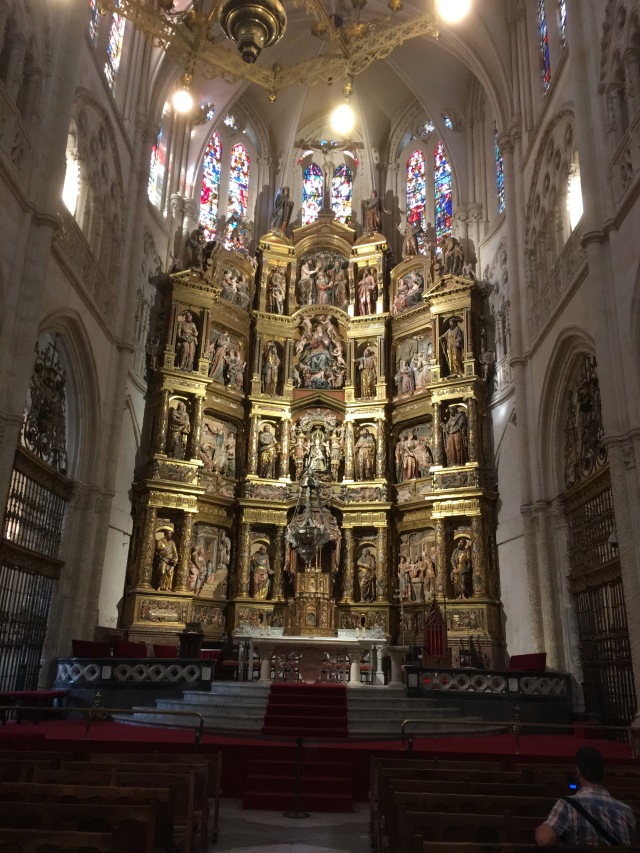
The Italian Renaissance paintings in the Burgos Cathedral moved me enormously. I imagine that each of us feels proud of our heritage. When I see this beautiful art, I sense my Italian roots and treasure the amazing artistic tradition that has interested me since I was 14 and discovered Michelangelo – read everything about his life and work that I could find. Those of you who have seen a Michelangelo sculpture in person or visited the Duomo in Florence may share that feeling.
For the next several days, we stayed overnight in Burgos and visited the city, as well as the Rioja region and Santo Domingo de la Calzada. Wine lovers must be sure to visit La Rioja during their walk on the Camino! Here is a series of photos of the beautiful town of Laguardia, a small town that towers way above the Rioja vineyards. Once you have had an opportunity to enjoy the views, I will provide a translation of the signs one encounters upon entering the main gate to Laguardia. It struck me that the area around Laguardia bears a certain resemblance to the landscapes of New Mexico:
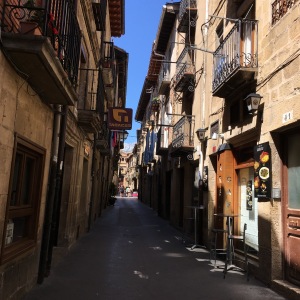
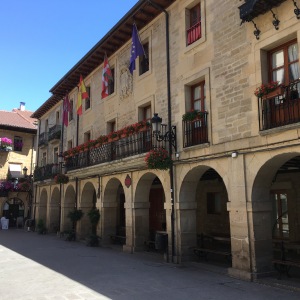
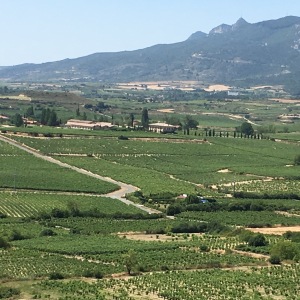
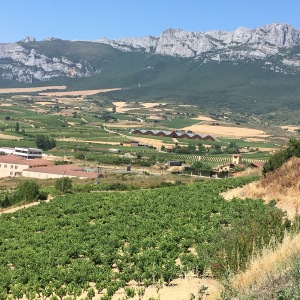
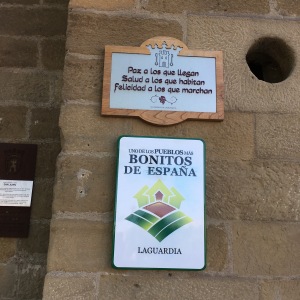
The upper plaque reads: Peace to those who arrive, health to those who live here, happiness to those who march. The lower one states that Laguardia has been designated one of the most beautiful small towns in Spain. I would have to agree with that.
Santo Domingo de la Calzada is a town that was founded by a man who wanted to provide refuge for pilgrims on the Camino. Today it is a fairly large town with a number of very interesting historic sites, including the cathedral. There is a legend that a young man and his family came there to stay at an inn. A young woman fell in love with the young man, but he did not share her feelings. She took revenge by accusing him of stealing a valuable item, which she hid in his belongings. He was arrested, and a judge condemned him to death. His family plead for his life. The judge responded that their son was as dead as the rooster on his dinner plate, at which point the rooster sprang back to life and saved the young man’s life. As a result, there is a live rooster living in the “Gallinero” (rooster coop) in the Cathedral of Santo Domingo de la Calzada. He has a hen for companionship. When he crows, you can hear him throughout every corner of the rather large cathedral and adjoining museum, which is well worth visiting.
We actually didn’t have enough time in this interesting and historic city. I would gladly return there for a visit to several historic monasteries and other sites dating back to Roman times. There is also a beautiful Parador in Santo Domingo de la Calzada, and I would highly recommend staying there. Paradores are wonderful hotels that have been created in historic buildings. The one in this city occupies the space of a 12th century hospital and is really gorgeous inside. Here are several photos of the city, including the Cathedral and Parador (the last photo in the series):
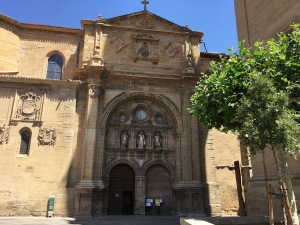
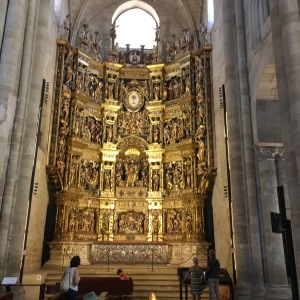
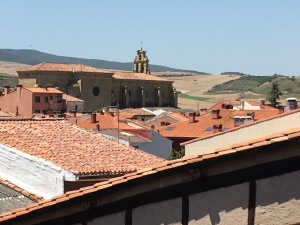
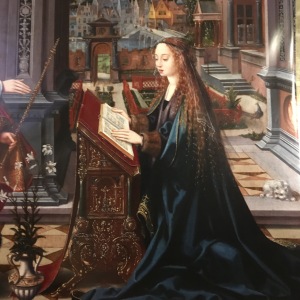
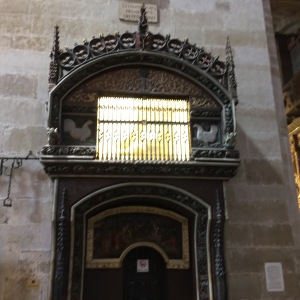
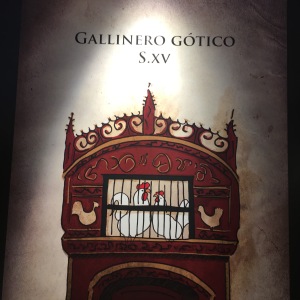
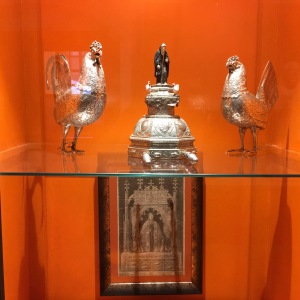
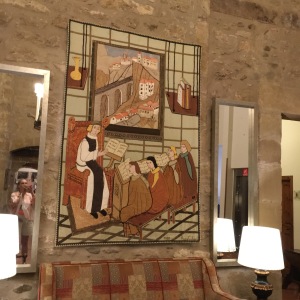
If you look closely at the last photo of the Parador, you will see that I accidentally photographed myself in the mirror on the left side of the photo while taking the shot. That was actually a rather fun coincidence.
After three nights and two days in Burgos and the surrounding region, we headed to our final destination for a driving-and-walking portion of the Camino, León, the capital city of the province of the same name. Here is a sneak preview of our hotel, also on a beautiful square by the beautiful Basilica of San Isidoro. The Basilica was built on the site of a former Roman temple. The museum adjoining the Basilica is a Must-See (caps intended!).
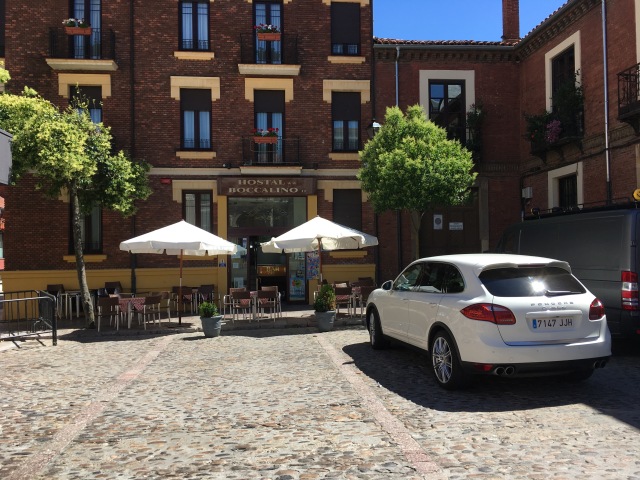
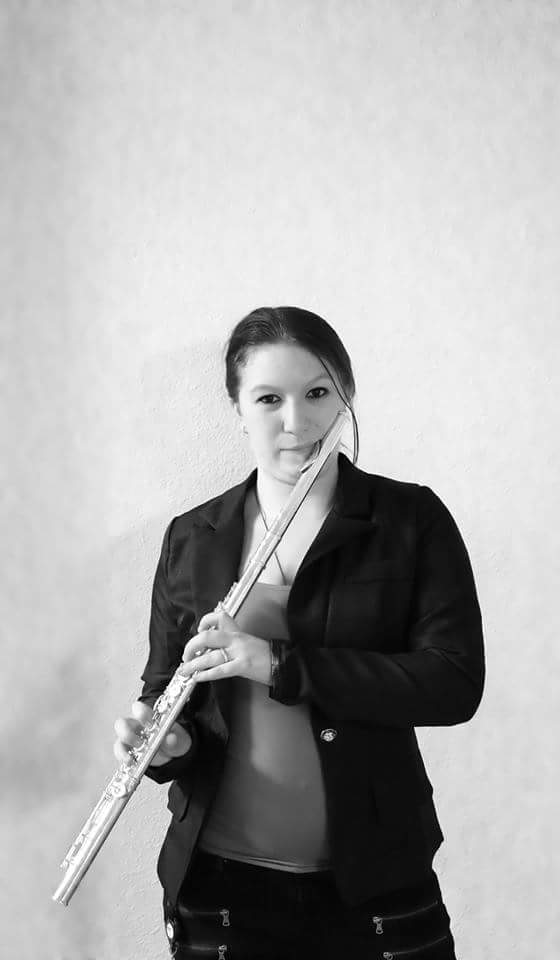
NMPAS would like to welcome our new intern, Samantha Gilbert. Sammi is a sophomore majoring in Contemporary Music at Santa Fe University of Art and Design. As you can see from the photo, her main instrument is flute.
Sammi has lived in many different parts of the US: Born in Massachusetts, she lived for 17 years in Evergreen, Colorado. In addition, she has spent a summer in Killeen, TX and, more recently, in Hancock, NY at the French Woods Performing Arts Festival.
One of the main reasons she sought an internship with NMPAS is that she loves the Santa Fe Community and wants to be more involved locally. Currently, she is studying flute from a classical perspective with Horace Young at SFUAD. She is mastering different aspects of flute playing, building repertoire, and refining her technique. Melinda Russial is also teaching her clarinet with a focus on Balkan music. This particularly relates to her major in Contemporary Music, and gives her the opportunity to focus on material that builds out her repertoire in this area.
By interning with NMPAS Sammi hopes to learn more about the business side of music. She loves performing, but there are so many advantages to also understanding and knowing the management side. This will provide additional experience in terms of what she hopes to do after finishing school. Ideally, she would like to end up in music therapy.
Sammi was also very involved in the marching band world in high school. In 2014 she was a member of the Cascades Drum and Bugle Corps, based out of Seattle. They traveled coast to coast, eventually ending up in Indiana for the Drum Corps International championships.
Tim Willson, a vocal soloist and member of the New Mexico Bach Chorale, commented on the musical side of the “Fireside Opera Chat”:
We were elated after the dress rehearsal. It helped make a major change in our attitudes, as we had been feeling as if we had not accomplished enough of our chores during the day. But that lost all importance after being transformed into the world of highest singing art.
Such grace, ease, expression, elegance, artistry … well, you know. That type of lyric singing with no lack of excitement, no lack of power. No wonder the career was so big. I wish I would hear that more often. I heard the greats of the past say ‘you should sing on the interest, not the capital.’ Here is proof. Most of us don’t do that, we give it too much. It is hard to hold back.
And the Stage deportment. I was learning new lessons on how to be with the orchestra, how to handle the lid of the piano, how to be relaxed but still deeply involved.
On Sunday evening, September 11, 2016, NMPAS presented a “Fireside Opera Chat.” The chat provided a behind-the-scenes look at life in the opera world. The event was hosted by Valerie and Bud Hamilton in their beautiful home. This was a truly joyful occasion!
The presenters – dramatic soprano Sue Patchell and opera conductor Franz Vote – are two musicians who have worked in the profession for over 40 years. Their friendship began in the early 1980s, when they worked together at the Theater im Revier in Gelsenkirchen, Germany. Since then, Sue has sung in every major European opera house and at the Metropolitan Opera. Franz moved from Gelsenkirchen to the Bavarian State Opera in Munich, Theater des Westens in Berlin, and the Bayreuth Wagner Festival. From there, he was invited by James Levine to join the conducting staff of the Metropolitan Opera. He conducted at the MET for 11 years. Sue’s debut at the MET in the late 1990s brought them together again after many years of pursuing separate paths.
The “Fireside Opera Chat” consisted of a dialogue with the audience, as well as a series of stories about their experiences in various opera houses, the people they have known, and the relationships they have enjoyed throughout their careers. Sue sang a selection of arias from her major roles in operas by Mozart, Puccini, Wagner, and Verdi, concluding with the “Liebestod” from Wagner’s “Tristan and Isolde.” She made her debut at the MET in the role of Isolde. Franz will always remember the roar that arose from the crowd as she took her bows. Maestro Levine refused the traditional bow and waived Sue back on stage instead. The orchestra remained in the pit to applaud her, which happens quite rarely with an orchestra that plays the repertoire so often.
Here are four photos taken at this evening’s event. The photographer is Esther Moses Bergh, an NMPAS board member and a soprano in the New Mexico Bach Chorale. NMPAS Music Director Franz Vote is seated at the piano. Executive director Linda Marianiello is seated by him as page turner. Sue Patchell is performing in several of the photos. Sue’s husband, baritone Brett Hamilton, is also pictured in the last photo.

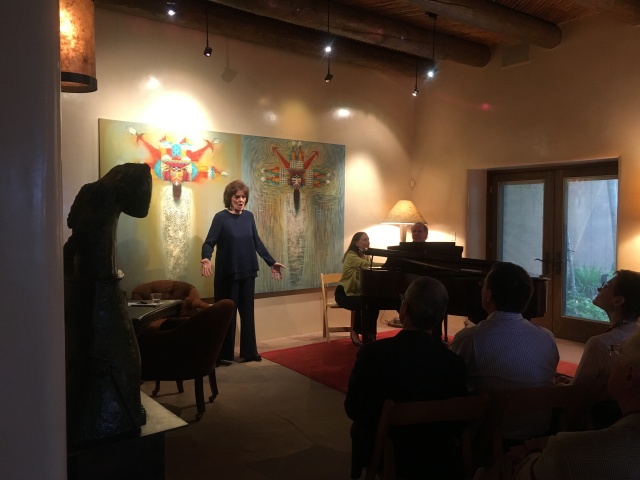
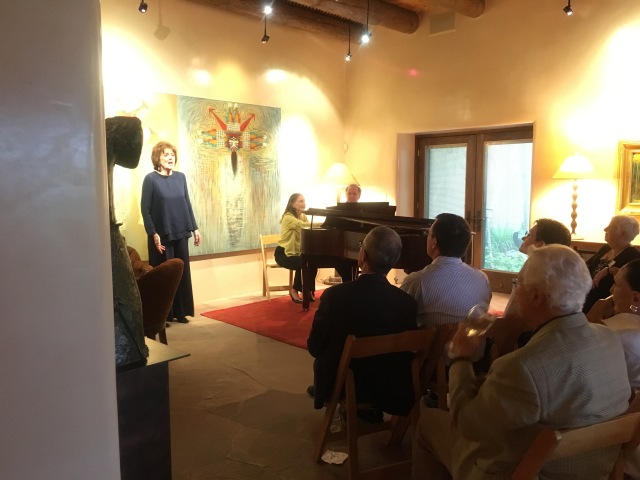

The next steps of the journey to Santiago de Compostela took me through Paris to visit a dear friend. We have known each other since 1985. She is a cellist who teaches at several of the most important conservatoires in Paris and lives in a nearby suburb. Here is a photo of Marly le Rois, a historic French town where the king once had a residence – it was destroyed during the French Revolution, but the town is still intact and well worth seeing. On my first evening, we enjoyed a meal of French crepes with hard cider in Marly.
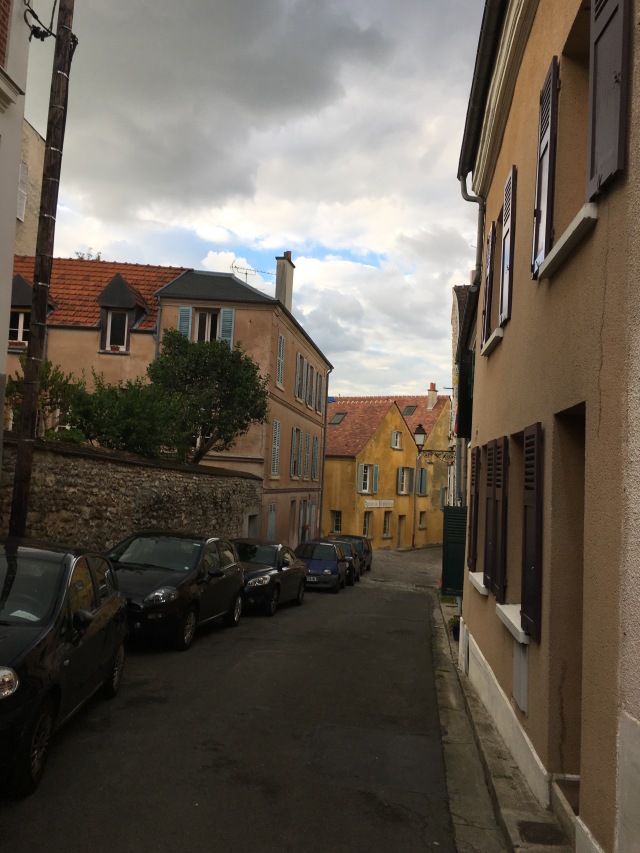
The next day, July 14th, was Bastille Day in France. To celebrate, we drove to St. Germain, where we visited all of the French specialty shops and had lunch at a lovely little bistro that we discovered quite by accident.
It was a short visit, because I was meeting a college friend in Pamplona the next day to begin our trip on the Camino. The train ride from Montparnasse to Pamplona will probably stay in my mind for the rest of my life, because it was a real adventure! In brief, the train schedule that I downloaded from the Deutsche Bahn website, which is supposed to be the most reliable in all of Europe, turned out to be wrong. I was supposed to arrive at the French-Spanish border to change trains in Irun, but my regional train stopped several kilometers short of that destination. In my best French and Spanish, I managed to find out how to get to Irun from Hendaye within an hour, to find the Renfe (Spanish Rail) station, to get my reserved seat and make the train just before it departed for Pamplona.
My guess is that much of this actually has to do with the fact that the Basque areas of France and Spain are in the process of establishing their own national identity. Truth be told, I was never so grateful for having studied several foreign languages and for being able to communicate with people in languages we both know!
Having managed to arrive in Pamplona with the right train, my friend met me at the station with our rental car. We planned to spend the first week visiting places along the Camino in the Meseta Central (Castilla y León) – where it was too hot to travel entirely on foot in July – as well as several cities in the Basque Region and La Rioja. On our first evening in Spain, we had a dinner of jamón serrano at a tapas bar. It was as good as Rick Steves says it is! Here is a photo of Old Pamplona.
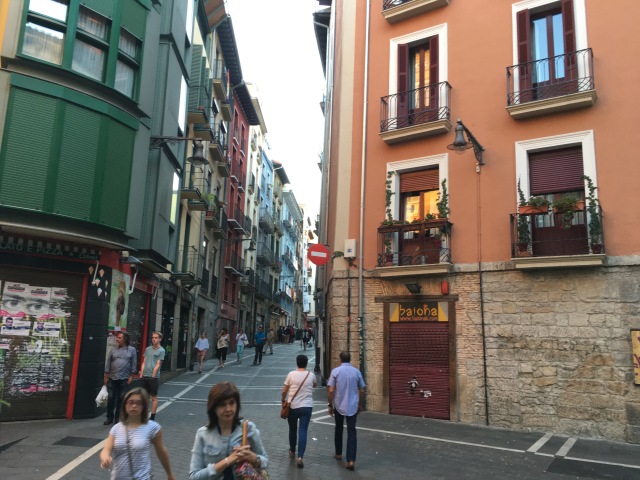
The next day we traveled to Bilbao, which is a fascinating city and well worth visiting. From there, we headed along the Atlantic Coast of Spain via San Sebastián to Comillas. We lucked out and found a parking space in San Sebastián near the beach, which is beautiful. There is a historic Casino right alongside the beach: it has been re-purposed as a library, but the architecture has been preserved, and the adjoining park makes for a wonderful stroll by the beach. It was also great to wade into the ocean for the first time in some years.
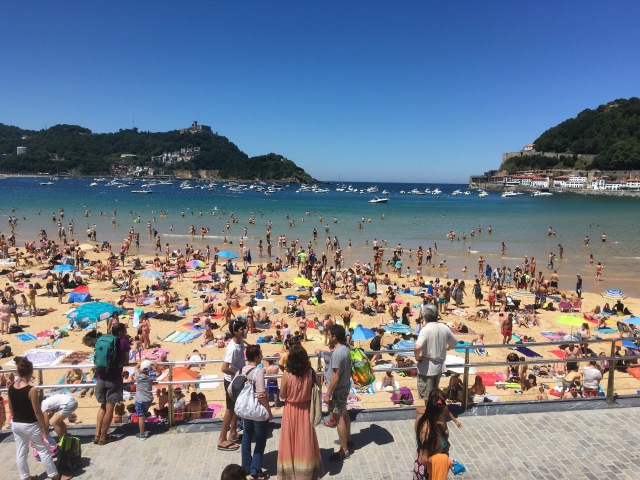
That same day we visited the Altamira Caves near Santilla del Mar. It was a Sunday, so we enjoyed a complimentary tour of the caves and museum. They are every bit as fascinating as the possibly more famous prehistoric Lascaux caves in France. We ended up in the neighboring city of Comillas, also on the Atlantic Coast with a wonderful beach. This small city has many incredible and historic sites dating back to the Middle Ages. The photo below is of Antoni Gaudi’s Capricho, a private home and one of the few examples of his work outside of Catalonia. After our visit, we had dinner at El Pirata, a great restaurant in Comillas that our hotel owner recommended. We had fish, of course!
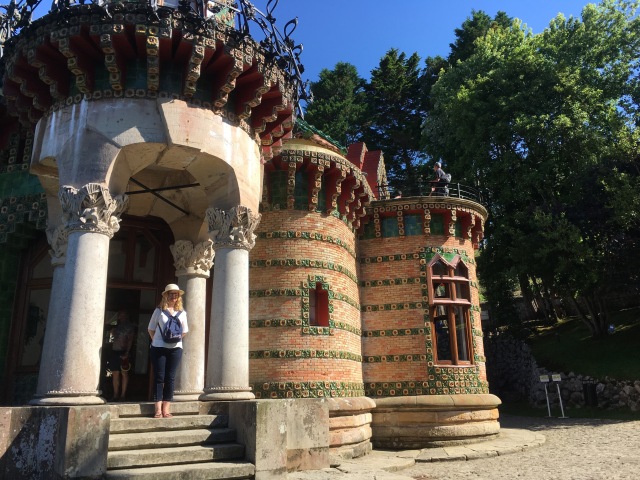
The next day took us to the very beautiful city of Burgos, the historic capital of Castilla. We’ll begin there in Part III. But I will close by mentioning that our hotel was across the plaza from the Burgos Cathedral. We ate breakfast in a lovely room on the second floor of the hotel with a view of the facade. It was very special.
In July 2016 I spent a month in Europe. My first real vacation in quite some time, it was a beautiful experience from start to finish. NMPAS had just finished our season on July 3rd. On July 5th I got on a plane to Munich, and left everything behind to enjoy music and a pilgrimage on the Camino.
When I arrived in Munich, a dear friend and colleague from the Bavarian State Opera met me at the airport. Reminder #1 of our life in Munich (1984-1993) was the great regional train system that took us right to her door! That first day we took the S-Bahn to the Starnberger See, one of Franz’s and my favorite places in Bavaria.
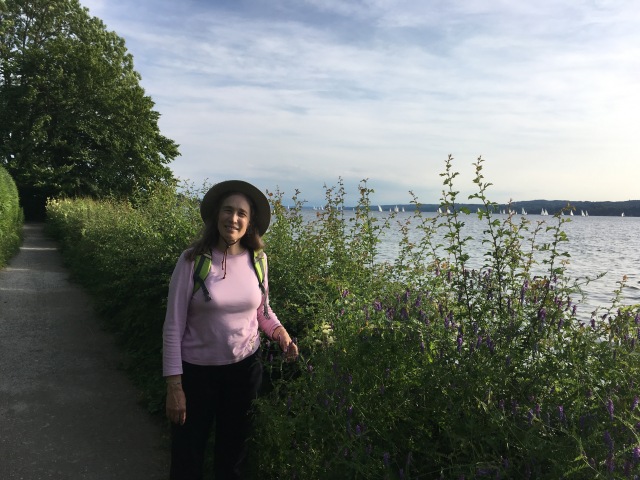
Things started off quickly with a six-hour rehearsal for two concerts on that first weekend. There wasn’t much time for jet lag, but the opportunity to play again with our violin, flute and piano trio was too tempting. Our pianist, Kazue Weber-Tsuzuki, reminded Jane Berger and me that the last time we played together was 26 years ago!
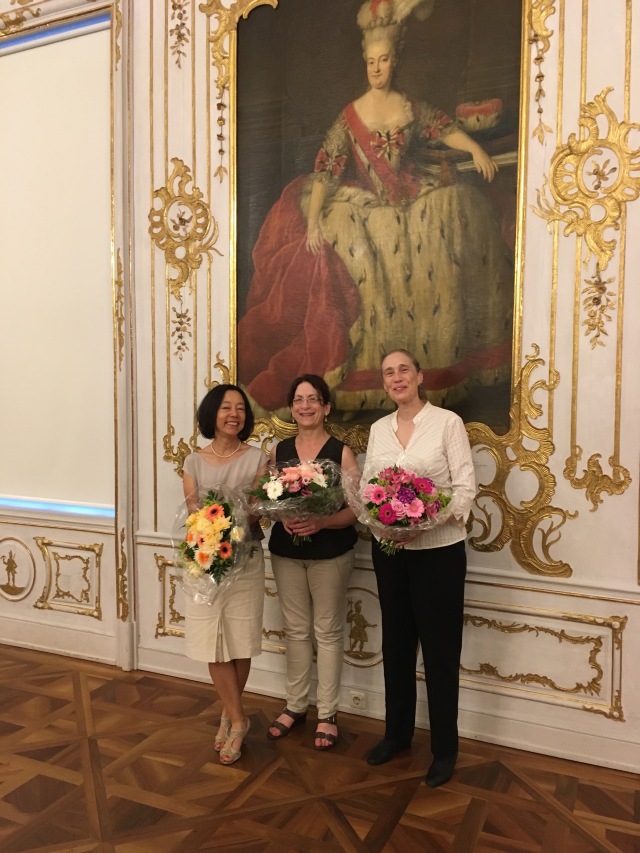
A week in Munich and Augsburg was all too short, but Paris and the Camino awaited me. Stay tuned for tales of training it to Paris, two fantastic meals at a creperie and French bistro, and another train trip to Pamplona.
The Camino de Santiago and NMPAS have something in common: They are both historic and have many stories to tell. Of course, the Camino has been around for much longer than NMPAS. People began to make pilgrimages from all over Europe beginning in 1100 CE. In walking the Camino one cannot help but think of the millions who have gone before on that very trail. And the arrival at the Cathedral in Santiago de Compostela is almost indescribably joyous and beautiful. We’ll be sharing more about “The Way of St. James” in subsequent installments of the Camino thread.
Yesterday I was thinking about the story of the “pilgrimage” that NMPAS has taken to arrive at where we are today. When our music director, Franz Vote, and I settled in Santa Fe in 2009, we expected to retire from music. We planned to transition to an entirely different phase of our lives. Little did we know that our colleagues in northern New Mexico had an entirely different idea!
Let me share a snapshot of how we came to be and what NMPAS has accomplished in four short seasons. Since we are beginning what many consider a landmark year – Number 5! – this is a great time to reflect and tell our story, which is still unfolding.
Two colleagues and I wanted to start a week-long flute masterclass in Santa Fe. So I visited the Immaculate Heart of Mary Retreat Center in summer 2010. The director, Jeff Snodgrass, took me into the Chapel. I was deeply moved by its beauty and peacefulness. Not only did he express interest in hosting our flute class – he also asked me if we could present a few concerts in the Chapel.
That first year we organized three concerts in the Chapel. We began small with perhaps 25-30 people in the audience. The musicians received the proceeds from ticket sales. At the third concert in May 2011, NMPAS music director Franz Vote conducted several pieces for chamber choir and instruments. The singers were so thrilled that they asked him to establish a professional choral group in order to work with him regularly. And so the New Mexico Bach Society, Chorale and Players was founded. Here is a photo of the original NM Bach Chorale at the debut concert in May 2012:
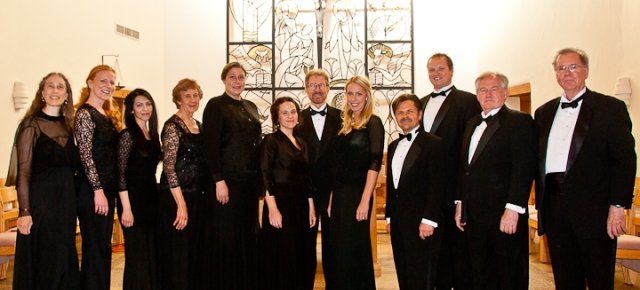
We are very blessed to have met two fantastic lawyers, Stefanie Kyser and Jim Rubin, who generously donated their time and expertise to NMPAS. Stefanie helped us to register at the state level and – thanks to Jim’s wise counsel – we received our IRS Determination Letter in less than a year after submitting our application.
Meanwhile, our series began to receive press coverage, audiences grew, and more and more musicians reached out to us. We now presented three series of events: The New Mexico Bach Society, The Chapel Series at Immaculate Heart, and Santa Fe Flute Immersion, our annual week-long flute and performance skills masterclass. The quality of our concerts has steadily increased to the point where we received two wonderful reviews in the Albuquerque Journal last season (Winter Solstice Review, Wagner Review). We began to notice that when we mentioned NMPAS, people’s eyes lit up. We had gone from being a new, relatively unknown arts organization to one that people knew through word of mouth and personal experience. The key word is experience – unless NMPAS concerts and events move people, and provide a meaningful “space” in which listeners can actively participate, we are not doing our job!
From the beginning, NMPAS and its founders were excited by collaboration with music presenters and other non-profits. To date we have participated in joint projects with many non-profits: The Immaculate Heart of Mary Retreat and Conference Center, The Archdiocese of Santa Fe, Serenata of Santa Fe, The Santa Fe Symphony, Chatter Albuquerque, Taos Chamber Music Group, New Mexico Highlands University, New Mexico State University Las Cruces, Carrizozo Music, the UNM John Donald Robb Musical Trust, and the Renesan Institute for Lifelong Learning, among others. In 2016-2017, NMPAS will celebrate new collaborations with El Rancho de las Golondrinas and the Los Alamos Little Theater.
Our mission has always been to provide meaningful employment for professional musicians and other artists who make their home in New Mexico. One of our board members recently pointed out that, in 2015-2016, 85% of the NMPAS budget was spent on artist fees! We are proud that our founders and staff have been able to devote four years to bringing NMPAS to the point where it is a firmly established, greatly appreciated professional arts organization with activities throughout northern New Mexico and beyond. None of this would have been possible without our wonderful donors, board members, committees and volunteers.
There is so much more to share, and we’ll be doing just that in the coming weeks and months. Let me close by mentioning our wonderful Business Partners – Los Alamos National Bank, First National Bank of Santa Fe, Cuddy & McCarthy LLC, Santa Fe Reporter, Santa Fe New Mexican, Hutton Broadcasting, Total Wine, El Rey Inn, and Verne Q. Powell Flutes – the Amazing Individual Donors, whose names you will find on our website (www.nmperformingartssociety.org), and the granting organizations that have helped to fund our seasons since 2013 – New Mexico Arts, the McCune Charitable Foundation, and the Santa Fe Arts Commission.
The New Mexico Performing Arts Society
Mailing Address:
7038 Camino Rojo
Santa Fe, NM 87507-3509
Office Address:
7038 Camino Rojo
Santa Fe, NM 87507
